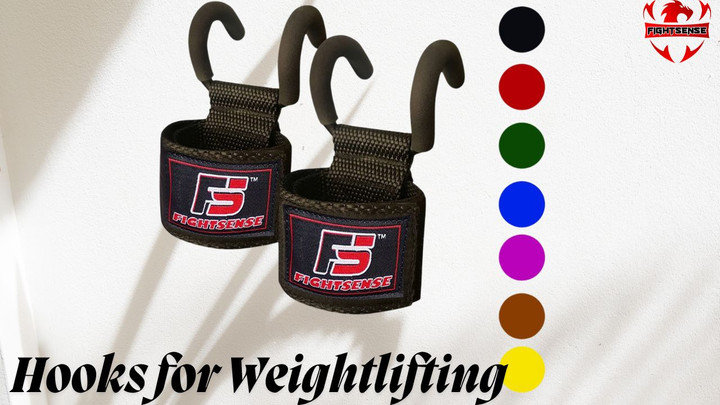How Hooks for Weightlifting Improve Strength Training
19th Mar 2025
You are not alone if you have battled with grip during weightlifting. Particularly with large movements like deadlifts or pull-ups, many lifters deal with this problem. Weightlifting hooks are made to assist you keep a strong hold, thereby enabling you to concentrate more on form and less on slip ability.
This post will go over what hooks for weightlifting are, how they operate, and why they might revolutionize your strength training program. We also will contrast them with hook grip weightlifting to see which fits you best.
Keynotes
-
Weightlifting hooks reduce grip fatigue for heavier lifts.
-
Focus on form, not grip strength, with hooks for weightlifting.
-
Choose from padded or adjustable weightlifting hooks.
-
Weightlifting hooks help prevent grip failure during heavy lifts.
-
Hooks for weightlifting are great for beginners.
What Are Hooks for Weightlifting?
These are specialized tools that hook onto the barbell to help with grip support. Usually worn around the wrists, these hooks include a robust, changeable strap that fastens your hand to the bar. These hooks primarily help to reduce the pressure on your fingers and forearms during large lifts.
They let you raise more weight without worrying about losing your grasp whether you're executing a pull-up, barbell lift, or any weight training exercise.
How Do Hooks for Weightlifting Work?
For weightlifting, hooks' mechanism is somewhat basic but efficient. The hook itself grips the barbell or other lifting tool when you fasten it around your wrist. This makes a strong link between you and the equipment such that you may lift without depending entirely on the power of your hands or forearms.
Using it lets you concentrate on lifting greater weights and improve your form, lowering your chance of hand muscle tiredness or strain.
Why Should You Consider Using Hooks for Weightlifting?
-
Enhanced Grasp Strength
Particularly on difficult lifts, it provides a consistent means of keeping a strong grasp on the bar. Deadlifts and other workouts where grip strength could restrict your improvement really benefit from this.
-
Improved performance
Reducing the effort needed to hold onto large weights, hooks for weightlifting let you raise more weight and complete more repetitions, therefore improving your gym performance.
-
Lower Forearm Weariness
Many times, heavy lifting causes forearm fatigue, which can make finishing your workout challenging. It frees your hands so you may concentrate on your main muscle groups.
-
Prevention of Harm
Should your grip fail during a lift, you may find yourself sacrificing your form, therefore raising your chance of damage. It guarantees that you keep a safe and under control lift without sacrificing your form.
Hook Grip Weightlifting vs. Weightlifting Hooks
Many lifters argue about which weightlifting technique—traditional or hook grip—to use. The following is a comparison:
-
Weightlifting using Hook Grips: This method locks the barbell by having your thumb around it with fingers. For individuals wishing to develop their grip during lifting, this is a great choice. It can be awkward, though, and mastery requires some work.
-
Tools for weightlifting hooks: For lifters who suffer with grip tiredness, these devices offer quick grip support and are fantastic. They let you concentrate totally on your form and strength, free from concern about your hands giving way.
While all choices have advantages and drawbacks, they can be a better fit for beginners or those lifting particularly large weights.
Types of Hooks for Weightlifting
Not every hook designed for weightlifting is made equal. Choosing the correct pair for you requires weighing several designs and characteristics.
1. Basic Hook Designs
These are the most often used and straightforward hooks since they provide a strong hold with few decorations. Usually composed of sturdy materials like steel or reinforced nylon.
2. Padded Hooks
Padded hooks could be a preferable choice if comfort takes front stage. They give your wrist more padding so that you may raise without any pain.
3. Modifiable Hooks
Certain hooks feature movable straps, which facilitates the ideal fit. These are fantastic if you require a personalized fit or intend to share your lifting accessories with others.
How to Use Hooks for Weightlifting Effectively
While weightlifting with hooks is simple, there are certain pointers to maximize their use:
-
The hooks should be tightly clasped around your wrists and not overly loose. A fitting snug will stop slippage during your lifts.
-
While weightlifting hooks will improve your grip, it's still vital to keep good lifting form to prevent damage and maximize results.
-
Use gradually: Start with getting acclimated to lighter weights by weightlifting utilizing hooks. Add your increasing confidence to more demanding lifts.
Final Thoughts
Any lifter's toolset should have hooks for weightlifting, particularly if you have ever suffered with grip tiredness during demanding training sessions. These hooks let you lift more and train harder by lowering the dependence on hand strength, therefore enhancing your general strength and performance.
It will enable you to progress you're training regardless of your level of experience. The hook grip weightlifting method is another option if you would want a more natural grasp. Your grip won't restrict your lifting potential using whichever technique you decide upon.
Key Takeaways
-
Reliable solutions for grip tiredness are weightlifting hooks.
-
They help you to concentrate on your form, so enhancing lifting performance.
-
Extra comfort and personalizing come from padded and changeable choices.
-
To find the best results, start with smaller weights and progressively raise the effort.
Including it in your training schedule will help you to guarantee that your grasp is one less concern for you and free you to concentrate on what really counts: lifting and increasing strength. Ready to lift your weightlifting? Now is the moment to try hooking!

